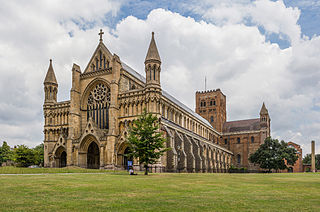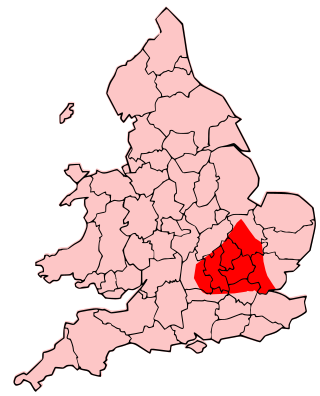St Albans is a city located in Hertfordshire, England. It was originally founded as Verlamion a settlement belonging to the Catuvellauni. It was subsequently transformed into the Roman settlement of Verulamium from where it grew into a municipium around AD 50.

Hatfield is a town and civil parish in Hertfordshire, England, in the borough of Welwyn Hatfield. It had a population of 29,616 in 2001, 39,201 at the 2011 Census, and 41,265 at the 2021 Census. The settlement is of Saxon origin. Hatfield House, home of the Marquess of Salisbury, forms the nucleus of the old town. From the 1930s when de Havilland opened a factory, until the 1990s when British Aerospace closed it, aircraft design and manufacture employed more people there than any other industry. Hatfield was one of the post-war New Towns built around London and has much modernist architecture from the period. The University of Hertfordshire is based there.

Hertfordshire is a ceremonial county in the East of England and one of the home counties. It borders Bedfordshire to the north-west, Cambridgeshire to the north-east, Essex to the east, Greater London to the south and Buckinghamshire to the west. The largest settlement is Watford, and the county town is Hertford.

St Albans is a cathedral city in Hertfordshire, England, east of Hemel Hempstead and west of Hatfield, 20 miles (32 km) north-west of London, 8 miles (13 km) south-west of Welwyn Garden City and 11 miles (18 km) south-east of Luton. St Albans was the first major town on the old Roman road of Watling Street for travellers heading north and became the city of Verulamium. It is within the London commuter belt and the Greater London Built-up Area.

Verulamium was a town in Roman Britain. It was sited southwest of the modern city of St Albans in Hertfordshire, England. A large portion of the Roman city remains unexcavated, being now park and agricultural land, although due to ploughing on the privately owned agricultural half of the city a lot of damage has been done, as proven by parts of mosaic floors that have been found on the surface, and results of ground penetrating radar show outlines of buildings as smudges rather than clearly defined walls like those protected by the parkland. Part of the Roman city has been built upon, such as St Michael's church and other parts along the centre of the medieval village. The major ancient Roman route Watling Street passed through the city. Much of the site and its environs is now a scheduled monument.

St Albans Cathedral, officially the Cathedral and Abbey Church of St Alban but often referred to locally as "the Abbey", is a Church of England cathedral in St Albans, England.

The Catuvellauni were a Celtic tribe or state of southeastern Britain before the Roman conquest, attested by inscriptions into the 4th century.

The Ver is a 28 km (17 mi) long chalk stream in Hertfordshire, England. It is a tributary of the River Colne.

St Albans is a constituency represented in the House of Commons of the UK Parliament since 2019 by Daisy Cooper, a Liberal Democrat.

Hitchin and Harpenden is a constituency represented in the House of Commons of the UK Parliament since 2017 by Bim Afolami, a Conservative.
Sopwell Priory was a Benedictine nunnery founded around 1140 on the site of an ancient hermitage in Sopwell, Hertfordshire, England. After the Dissolution, the priory was torn down and a Tudor manor house constructed in its place.

Verulamium Park is a park in St Albans, Hertfordshire. Set in over 100 acres (0.40 km2) of parkland, Verulamium Park was purchased from the Earl of Verulam in 1929 by the then City Corporation. Today the park is owned and operated by St Albans City and District Council.

Verlamion, or Verlamio, was a settlement in Iron Age Britain. It was a major centre of the Catuvellauni tribe from about 20 BC until shortly after the Roman invasion of AD 43. It is associated with a particular king, Tasciovanus. Its location was on Prae Hill, 2 km to the west of modern St Albans.

Sopwell House is a historic Georgian country house, now a luxury 128 bedroom hotel, country club & spa located south of St Albans, Hertfordshire, England. It gained fame as the gathering place for the England national football team before international football events. It has also hosted other club and international football teams. The facilities include a conference & banqueting centre, 2 restaurants, 2 bars, gym, dance studio, and spa.

Isca, variously specified as Isca Augusta or Isca Silurum, was the site of a Roman legionary fortress and settlement or vicus, the remains of which lie beneath parts of the present-day suburban town of Caerleon in the north of the city of Newport in South Wales. The site includes Caerleon Amphitheatre and is protected by Cadw.

The Alban Way is a shared-use path along the former Hatfield and St Albans Railway in Hertfordshire, England. The route is 6.3 miles (10.1 km) long and is owned by St Albans City & District Council and Welwyn Hatfield Borough Council, within their respective boundaries.

Geoffrey de Gorham, sometimes called Geoffrey of Dunstable or of Le Mans, was a Norman scholar who became Abbot of St Albans Abbey, 1119 to 1146.
Frederick George Kitton was a British wood-engraver, author, and illustrator. He is best known for illustrating and editing the works of Charles Dickens.

St Albans Town Hall, sometimes known as the Old Town Hall or The Courthouse, is a 19th-century building in St Albans, Hertfordshire, England. The building, which now accommodates the St Albans Museum, is a Grade II* listed building.




















